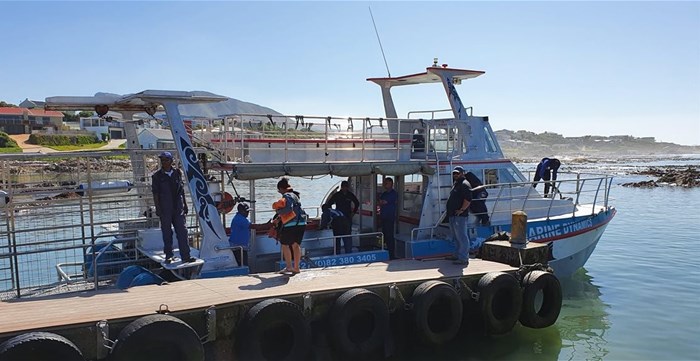
Related
Top stories






More news












The first thing that struck me is that this is not just an outfit providing photo ops for foreign tourists willing to fork out the big bucks, but a sustainable way of supporting research as Marine Dynamics partners with the Dyer Island Conservation Trust and carries out data collecting on the marine life in the area.
We had on board with us, marine biologist and guide, Kelly Baker. When she and her band of young volunteers weren’t stuffing us into our somewhat snug wetsuits and tending to those feeling a bit queasy, they were taking readings on the ocean conditions and gathering data.
Baker’s passion for sharks is tangible and she’s a fountain of knowledge. Did you know that no-one has ever witnessed a great white give birth?
She also filled us in on changes in marine animal behaviour in the past few years. For example, the great white numbers have dwindled in the Gansbaai area, because of, the scientists believe, the arrival of orcas (aka killer whales – which are actually part of the dolphin family). The story goes that three years ago, the bodies of four great whites washed up. When they were dissected, they were all missing their livers, which is an indication that the sharks were hunted by orcas, their only known predator besides man.
The departure of great whites saw an increase in the number of another species, namely the bronze whaler shark (bronzie), as well as southern right whales.
The whole shark cage diving experience starts at the Marine Dynamics HQ, where we got breakfast and a safety briefing. One thing that was made very clear throughout the day was that because we were viewing sharks in their natural environment, they could not be summoned at will, so sightings were not guaranteed.
We chose the perfect day. The sea was flat, the sun was shining and there was very little wind. Next we headed off to Marine Dynamics’ custom-built vessel, Slashfin, named after a legendary great white that frequented the area.

Very soon, we were making the 15 minute journey to The Shallows, where sightings are common. Once we arrived, we anchored, and one of the crew started chumming the water with a mixture of fish offal and oil and the cage is lowered off the side of the vessel.
Then it becomes a waiting game, with a lot of the time spent suspended in a cage on the side of the boat waiting for the sharks to come. On the day we did see a couple of bronze whalers, or bronzies, but alas no great whites. Although a few of the foreign visitors were a bit disappointed, in truth the lack of sharks didn’t detract from the whole awesome experience.
